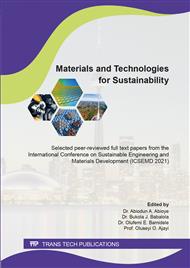[1]
M. Meikandan, M. Sundarraj, D. Yogaraj, K. Malarmohan, Experimental and numerical investigation on bare tube cross flow heat exchanger-using COMSOL, Int. J. Ambient Energy. 41 (2020). https://doi.org/10.1080/01430750.2018.1472650.
DOI: 10.1080/01430750.2018.1472650
Google Scholar
[2]
L. Liu, T. Zeng, H. Huang, M. Kubota, N. Kobayashi, Z. He, J. Li, L. Deng, X. Li, Y. Feng, K. Yan, Numerical modelling and parametric study of an air-cooled desiccant coated cross-flow heat exchanger, Appl. Therm. Eng. 169 (2020). https://doi.org/10.1016/j.applthermaleng.2020.114901.
DOI: 10.1016/j.applthermaleng.2020.114901
Google Scholar
[3]
F.C. Magazoni, L. Cabezas-Gómez, P.F. Alvariño, J.M. Sáiz-Jabardo, Closed form relationships of temperature effectiveness of cross-flow heat exchangers, Therm. Sci. Eng. Prog. 9 (2019). https://doi.org/10.1016/j.tsep.2018.11.005.
DOI: 10.1016/j.tsep.2018.11.005
Google Scholar
[4]
T. Gao, J. Geer, B. Sammakia, Review and analysis of cross flow heat exchanger transient modeling for flow rate and temperature variations, J. Therm. Sci. Eng. Appl. 7 (2015). https://doi.org/10.1115/1.4031222.
DOI: 10.1115/1.4031222
Google Scholar
[5]
A. El Maakoul, A. Laknizi, S. Saadeddine, M. El Metoui, A. Zaite, M. Meziane, A. Ben Abdellah, Numerical comparison of shell-side performance for shell and tube heat exchangers with trefoil-hole, helical and segmental baffles, Appl. Therm. Eng. 109 (2016). https://doi.org/10.1016/j.applthermaleng.2016.08.067.
DOI: 10.1016/j.applthermaleng.2016.08.067
Google Scholar
[6]
Y. Long, S. Wang, J. Wang, T. Zhang, Mathematical Model of Heat Transfer for a Finned Tube Cross-flow Heat Exchanger with Ice Slurry as Cooling Medium, in: Procedia Eng., 2016. https://doi.org/10.1016/j.proeng.2016.06.386.
DOI: 10.1016/j.proeng.2016.06.386
Google Scholar
[7]
M.S.Y. Ebaid, A.M. Ghrair, M. Al-Busoul, Experimental investigation of cooling photovoltaic (PV) panels using (TiO2) nanofluid in water -polyethylene glycol mixture and (Al2O3) nanofluid in water- cetyltrimethylammonium bromide mixture, Energy Convers. Manag. 155 (2018). https://doi.org/10.1016/j.enconman.2017.10.074.
DOI: 10.1016/j.enconman.2017.10.074
Google Scholar
[8]
M.A. Arie, D.M. Hymas, F. Singer, A.H. Shooshtari, M. Ohadi, An additively manufactured novel polymer composite heat exchanger for dry cooling applications, Int. J. Heat Mass Transf. 147 (2020). https://doi.org/10.1016/j.ijheatmasstransfer.2019.118889.
DOI: 10.1016/j.ijheatmasstransfer.2019.118889
Google Scholar
[9]
L.Z. Zhang, Z.X. Li, T.S. Zhong, L.X. Pei, Flow maldistribution and performance deteriorations in a cross flow hollow fiber membrane module for air humidification, J. Memb. Sci. 427 (2013). https://doi.org/10.1016/j.memsci.2012.09.030.
DOI: 10.1016/j.memsci.2012.09.030
Google Scholar
[10]
R.S. Matos, T.A. Laursen, J.V.C. Vargas, A. Bejan, Three-dimensional optimization of staggered finned circular and elliptic tubes in forced convection, Int. J. Therm. Sci. 43 (2004). https://doi.org/10.1016/j.ijthermalsci.2003.10.003.
DOI: 10.1016/j.ijthermalsci.2003.10.003
Google Scholar
[11]
S. Salari, S.M. Jafari, Application of nanofluids for thermal processing of food products, Trends Food Sci. Technol. 97 (2020). https://doi.org/10.1016/j.tifs.2020.01.004.
DOI: 10.1016/j.tifs.2020.01.004
Google Scholar
[12]
H. Moghadasi, E. Aminian, H. Saffari, M. Mahjoorghani, A. Emamifar, Numerical analysis on laminar forced convection improvement of hybrid nanofluid within a U-bend pipe in porous media, Int. J. Mech. Sci. 179 (2020). https://doi.org/10.1016/j.ijmecsci.2020.105659.
DOI: 10.1016/j.ijmecsci.2020.105659
Google Scholar
[13]
Y.S. Dhale, L. P., Wadhave, P. B., Kanade, D. V., Sable, Effect of nanofluid on cooling system of engine, Int. J. Eng. Appl. Sci. 2 (2015) 8–10.
Google Scholar
[14]
Y.B. Tao, Y.L. He, Z.G. Wu, W.Q. Tao, Three-dimensional numerical study and field synergy principle analysis of wavy fin heat exchangers with elliptic tubes, Int. J. Heat Fluid Flow. 28 (2007). https://doi.org/10.1016/j.ijheatfluidflow.2007.02.001.
DOI: 10.1016/j.ijheatfluidflow.2007.02.001
Google Scholar
[15]
Y. Xuan, Q. Li, Heat transfer enhancement of nanofluids, Int. J. Heat Fluid Flow. 21 (2000) 58–64. https://doi.org/10.1016/S0142-727X(99)00067-3.
DOI: 10.1016/s0142-727x(99)00067-3
Google Scholar
[16]
M.G. Rao, P.P. Kumar, A.M.V. Praveen, Numerical Investigation of Heat Transfer Characteristics of a Nano Fluid in a Circumferential Fin Tube Heat Exchanger, Int. J. Adv. Eng. Res. Dev. 4 (2017). https://doi.org/10.21090/ijaerd.99155.
DOI: 10.21090/ijaerd.99155
Google Scholar
[17]
S. Jayavel, S. Tiwari, Numerical study of heat transfer and pressure drop for flow past inline and staggered tube bundles, Int. J. Numer. Methods Heat Fluid Flow. 19 (2009). https://doi.org/10.1108/09615530910994432.
DOI: 10.1108/09615530910994432
Google Scholar
[18]
C.K. Mangrulkar, A.S. Dhoble, S.G. Chakrabarty, U.S. Wankhede, Experimental and CFD prediction of heat transfer and friction factor characteristics in cross flow tube bank with integral splitter plate, Int. J. Heat Mass Transf. 104 (2017). https://doi.org/10.1016/ j.ijheatmasstransfer.2016.09.013.
DOI: 10.1016/j.ijheatmasstransfer.2016.09.013
Google Scholar
[19]
T.K. Bose, Numerical Fluid Dynamics, Narosa Publ, House, London, (1997).
Google Scholar
[20]
Y.A. Cengel, M.A. Boles, Thermodynamics: An Engineering Approach, Fourth, New York, (2002).
Google Scholar
[21]
M.A. Ahmed, M.M. Yaseen, M.Z. Yusoff, Numerical study of convective heat transfer from tube bank in cross flow using nanofluid, Case Stud. Therm. Eng. 10 (2017). https://doi.org/10.1016/j.csite.2017.11.002.
DOI: 10.1016/j.csite.2017.11.002
Google Scholar
[22]
A. Mahdy, H.M. ElShehabey, Uncertainties in physical property effects on viscous flow and heat transfer over a nonlinearly stretching sheet with nanofluids, Int. Commun. Heat Mass Transf. 39 (2012) 713–719. https://doi.org/10.1016/J.ICHEATMASSTRANSFER. 2012.03.019.
DOI: 10.1016/j.icheatmasstransfer.2012.03.019
Google Scholar
[23]
H.F. Oztop, E. Abu-Nada, Numerical study of natural convection in partially heated rectangular enclosures filled with nanofluids, Int. J. Heat Fluid Flow. 29 (2008). https://doi.org/10.1016/j.ijheatfluidflow.2008.04.009.
DOI: 10.1016/j.ijheatfluidflow.2008.04.009
Google Scholar
[24]
M.A. Ahmed, N.H. Shuaib, M.Z. Yusoff, A.H. Al-Falahi, Numerical investigations of flow and heat transfer enhancement in a corrugated channel using nanofluid, Int. Commun. Heat Mass Transf. 38 (2011) 1368–1375. https://doi.org/10.1016/j.icheatmasstransfer.2011.08.013.
DOI: 10.1016/j.icheatmasstransfer.2011.08.013
Google Scholar
[25]
M.A. Ahmed, M.Z. Yusoff, K.C. Ng, N.H. Shuaib, Effect of corrugation profile on the thermal-hydraulic performance of corrugated channels using CuO-water nanofluid, Case Stud. Therm. Eng. 4 (2014). https://doi.org/10.1016/j.csite.2014.07.001.
DOI: 10.1016/j.csite.2014.07.001
Google Scholar
[26]
M. Vegad, S. Satadia, P. Pradip, P. Chirag, P. Bhargav, Heat Transfer Characteristics of Low Reynolds Number Flow of Nanofluid Around a Heated Circular Cylinder, Procedia Technol. 14 (2014). https://doi.org/10.1016/j.protcy.2014.08.045.
DOI: 10.1016/j.protcy.2014.08.045
Google Scholar
[27]
M. Ali, A.M. El-Leathy, Z. Al-Sofyany, The effect of nanofluid concentration on the cooling system of vehicles radiator, Adv. Mech. Eng. 2014 (2014). https://doi.org/10.1155/2014/962510.
DOI: 10.1155/2014/962510
Google Scholar
[28]
P.K. Namburu, K. Debendra Das, S. Ravikanth Vajjha, Comparison of the performance of copper oxide nanofluid with water in electronic cooling, J. ASTM Int. 9 (2012). https://doi.org/10.1520/JAI104342.
DOI: 10.1520/jai104342
Google Scholar


